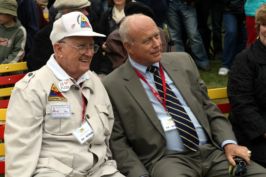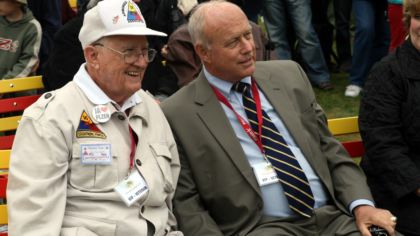Reverend Kenneth S. Jones
How I Liberated a Brewery
Pastor Kenneth S. Jones
My military duties with the 16th Armored Division, U.S.Army, were to serve as Division Information Officer, an important educative responsibility while in training in America, but once overseas, I functioned as more of an in-house or staff journalist. Officially, I was a part of the Headquarters Company, but no one seemed to care what I was doing. When I identified the unit that had been instructed to liberate the brewery, I thought that would be newsworthy and attached myself to that unit. This entitled me to claim, for posterity’s sake, that I had helped to liberate the brewery. The German soldiers we found in the brewery complex were eager to surrender, so it was almost a “non event”.
Before our liberation of Pilsen, we were assigned to the village of Tachau (Tachov), and set up headquarters there to wait for our commitment to battle. Some of you will have heard that, in order to entertain the American troops in Europe, there were entertainment programs put on by beloved movie stars and popular bands, all provided by the U.S.O. Tours. There I was in Tachau, with nothing to do, when along came Ingrid Bergman, a very popular movie star from Sweden. She was supposed to entertain the troops in Hitler’s vast stadium in Nuremberg, but she was lost… a couple of hundred miles lost… I told her that we would see that she got to Nuremberg, but before I helped her, I called an impromptu gathering of our 16th Armored Division soldiers to enjoy her charms. She didn’t sing or dance – she just stood there and talked with her delicious Scandinavian accent. The next day, we sent her on her way. Actually, she had a G.I. driver and a vehicle, so all we had to do was mark a map for her.
After the war, I became a United Methodist pastor and served churches for 37 years, before retiring in 1986. At the 2000 dedication of the 16th Armored Division monument in front of the Treasury Building in Pilsen, I discovered that there was a United Methodist Church at that very intersection. So, we worshipped there on Sunday morning, and the pastor asked me to lead a team of volunteers to remove the elevated seating which had been installed in the sanctuary during the Russian occupation. In 2002, I brought a team of five men and five women from America and we succeeded in removing all the wooden structure that supported those 13 tiers of seating. The Russians had used the church as a lecture hall for the Russian troops. Because we were there on a Sunday, I was invited to preach to the next generation of worshippers who were enjoying the once lovely building. When I told the congregation that I had personally liberated the brewery, they broke into applause, right in the middle of my message, something that had never happened in my lifetime of preaching.
My first impression of Czechoslovakia was that I was gazing upon the most unbelievably beautiful countryside I had ever seen – the rolling hills, topped with evergreen forests, provided a backdrop for fields of waving grain, as men and women harvested the winter wheat and stacked it onto hay wagons, drawn by horses. It was like a painting by an 18th– century master. And, if that wasn’t enough, the frequent dark gray granite outcroppings among the wheat were like after-thoughts by an artist to improve on perfection. Thanks to the city fathers of Pilsen, I have visited this glorious country five more times since the war – in 1995, 2000, 2002, 2005 and 2010.
From book 500 hours to victory

